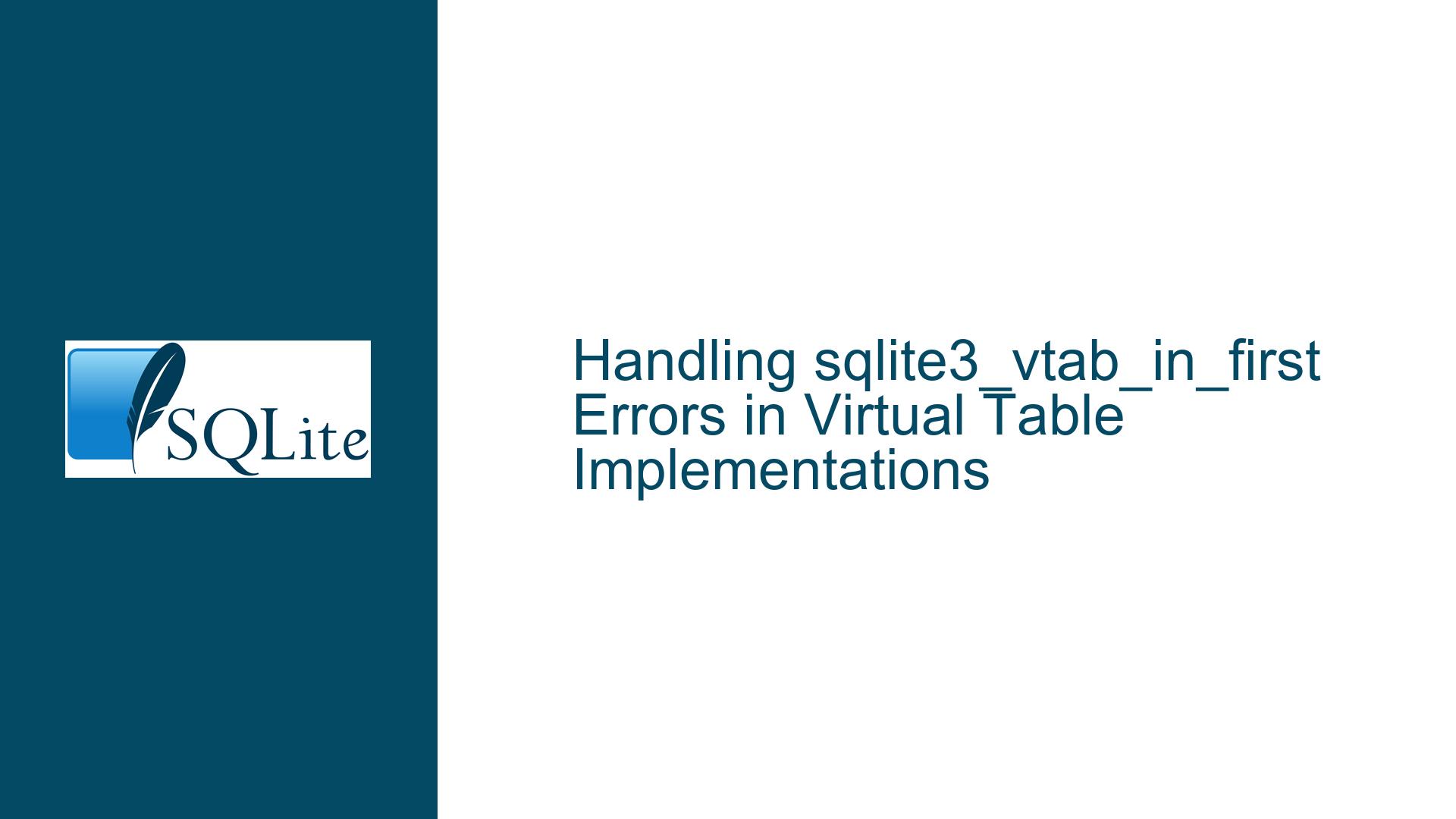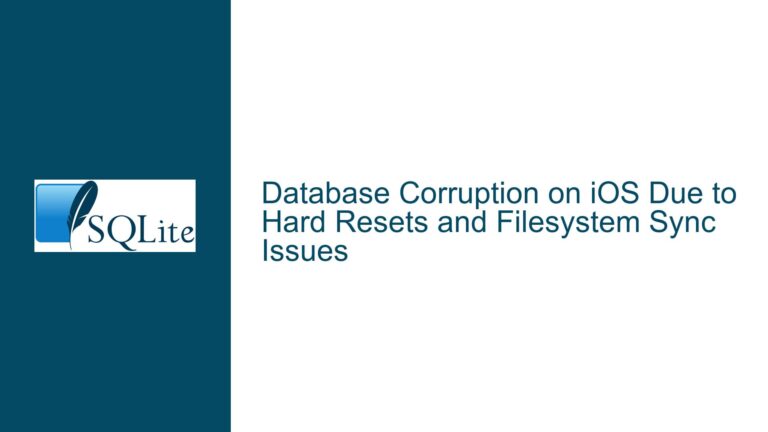Handling sqlite3_vtab_in_first Errors in Virtual Table Implementations
Issue Overview: Misuse of sqlite3_vtab_in_first Without Prior sqlite3_vtab_in Calls
Virtual tables in SQLite allow developers to define custom data sources that behave like native tables. A critical aspect of virtual table implementation involves handling constraints, particularly those involving IN clauses with multiple values. The xBestIndex and xFilter methods are central to this process. The xBestIndex method is responsible for determining the optimal query plan, while xFilter executes the plan.
When an IN constraint is present, the sqlite3_vtab_in function must be called during xBestIndex to signal that the constraint will be processed as a multi-value list. Subsequently, sqlite3_vtab_in_first and sqlite3_vtab_in_next are used in xFilter to iterate over the values in the IN list. The problem arises when a developer calls sqlite3_vtab_in_first or sqlite3_vtab_in_next on a parameter that was not properly initialized with sqlite3_vtab_in. Prior to SQLite version 3.41.0, this misuse could lead to undefined behavior or SQLITE_MISUSE errors, depending on the context. The documentation explicitly warned that such misuse might result in harmful outcomes, but the exact behavior was not guaranteed.
The crux of the issue lies in the developer’s need to track which parameters (identified by argvIndex) were initialized with sqlite3_vtab_in during xBestIndex. Failing to do so could result in erroneous calls to iteration functions. For developers creating abstractions or wrappers around SQLite (e.g., for Python integration), manually tracking argvIndex values across xBestIndex and xFilter introduces complexity. This tracking requires additional memory allocation and awareness of SQLite’s internal behavior, such as how multiple constraints might share the same argvIndex or how the "winning" query plan is selected when xBestIndex is called multiple times.
The undefined behavior described in earlier SQLite versions posed a significant risk. For instance, calling sqlite3_vtab_in_first on a non-IN parameter could lead to memory corruption, crashes, or incorrect query results. Developers relying on testing suites to catch these issues faced challenges because the undefined nature meant that behavior might vary across SQLite versions or platforms. This unpredictability made it difficult to ensure robustness in virtual table implementations, especially when targeting multiple SQLite versions.
Possible Causes: Improper Tracking of IN Constraints Across xBestIndex and xFilter
The root cause of errors when using sqlite3_vtab_in_first stems from a misalignment between the setup phase (xBestIndex) and the execution phase (xFilter). During xBestIndex, the virtual table implementation must identify which constraints correspond to multi-value IN clauses and register them using sqlite3_vtab_in. Each registered constraint is assigned an argvIndex, which is later used in xFilter to access the values. However, developers often face these challenges:
Lack of State Propagation Between xBestIndex and xFilter: The
xBestIndexmethod is invoked during query planning, whilexFilteris called during execution. The virtual table implementation must propagate state (e.g., whichargvIndexvalues correspond toINconstraints) between these two phases. This typically involves storing metadata in theidxStrfield or allocating memory to trackargvIndexmappings. Developers who omit this state propagation will lack the necessary information inxFilterto determine which parameters are valid for iteration.Ambiguity in argvIndex Assignment: SQLite allows multiple constraints to share the same
argvIndex, especially when the query optimizer explores different plans. If a developer does not account for this possibility, they might incorrectly assume that eachargvIndexuniquely identifies a single constraint. This can lead to false positives when iterating overINlists, as multiple constraints might inadvertently reuse the same index.Resource Overhead in Tracking IN Constraints: Accurately tracking
INconstraints requires additional memory and computational overhead. For example, a virtual table with dozens of constraints would need to allocate arrays or bitmaps to track whichargvIndexvalues were initialized withsqlite3_vtab_in. Developers working on lightweight wrappers or high-performance virtual tables might avoid this overhead, opting instead to risk callingsqlite3_vtab_in_firstunconditionally. This approach, while efficient, violates the API contract and exposes the implementation to undefined behavior.Misinterpretation of SQLITE_NULL Values: Some developers attempt to infer
INconstraints by checking if a parameter’s type isSQLITE_NULL(a convention used in certain SQLite versions). However, this is unreliable becauseNULLcan arise from other contexts, such as unbound parameters or explicitNULLliterals. Relying onsqlite3_value_typechecks without explicit tracking ofsqlite3_vtab_incalls can lead to false assumptions.Version-Specific Behavior: Prior to SQLite 3.41.0, the consequences of misusing
sqlite3_vtab_in_firstwere not fully defined. Some versions might returnSQLITE_MISUSE, while others could crash or corrupt memory. Developers writing cross-version compatible code found it difficult to handle these inconsistencies, as the same misuse might behave differently across environments.
Troubleshooting Steps, Solutions & Fixes: Ensuring Correct Usage of sqlite3_vtab_in Functions
Step 1: Adhere to the API Contract for IN Constraint Handling
The primary solution is to strictly follow the API contract: always call sqlite3_vtab_in during xBestIndex for parameters that will be processed as multi-value IN constraints, and use the corresponding argvIndex in xFilter to iterate with sqlite3_vtab_in_first and sqlite3_vtab_in_next. To implement this correctly:
Track
argvIndexValues inxBestIndex: When processing constraints inxBestIndex, identify those that representINclauses and callsqlite3_vtab_infor each. Store the assignedargvIndexvalues in a structure that persists betweenxBestIndexandxFilter. TheidxStrfield is ideal for this purpose, as it is passed toxFilterand can be used to encode metadata.Example of encoding
INconstraint information intoidxStr:// During xBestIndex char *idxStr = sqlite3_malloc(nConstraints + 2); idxStr[0] = (char)inConstraintCount; // Number of IN constraints for (int i = 0; i < nConstraints; i++) { if (constraintIsIN[i]) { idxStr[i+1] = (char)argvIndex; // Store argvIndex for each IN constraint } } sqlite3_vtab_config(db, SQLITE_INDEX_USING_IDXSTR);Decode
idxStrinxFilter: InxFilter, parse theidxStrto retrieve theargvIndexvalues that were initialized withsqlite3_vtab_in. Use these indices to safely callsqlite3_vtab_in_firstandsqlite3_vtab_in_next.
Step 2: Leverage SQLite’s Enhanced Error Handling (Version 3.41.0+)
Starting with SQLite 3.41.0, misuse of sqlite3_vtab_in_first and sqlite3_vtab_in_next reliably returns SQLITE_ERROR instead of exhibiting undefined behavior. This allows developers to detect and handle errors gracefully. To take advantage of this:
Upgrade to SQLite 3.41.0 or Later: Ensure your environment uses a version of SQLite that includes the fix. This eliminates the risk of memory corruption and standardizes the error response.
Check Return Values Rigorously: After calling
sqlite3_vtab_in_firstorsqlite3_vtab_in_next, check if the return code isSQLITE_ERROR. If so, log an error or halt further processing of the constraint.Example error handling:
int rc = sqlite3_vtab_in_first(pVal, &pFirst); if (rc == SQLITE_ERROR) { // Handle invalid IN parameter return SQLITE_ERROR; }
Step 3: Validate and Initialize sqlite3_value Objects
The forum discussion highlighted an issue where sqlite3_value objects passed to xFilter had uninitialized xDel fields, leading to valgrind warnings. This occurs when SQLite internally constructs sqlite3_value objects (e.g., for NULL literals or unbound parameters) without fully initializing all members. To mitigate this:
Avoid Assumptions About sqlite3_value Internals: Treat
sqlite3_valueas an opaque structure. Use only public APIs likesqlite3_value_type,sqlite3_value_int, etc., to interact with values.Test with Valgrind or Address Sanitizers: Integrate memory-checking tools into your test suite to identify uninitialized memory accesses. The example valgrind trace provided in the discussion was critical for diagnosing the
xDelissue.
Step 4: Implement Comprehensive Test Cases
Developers wrapping SQLite for other languages (e.g., Python) must ensure their test suites cover edge cases involving IN constraints. Key scenarios include:
Variable-Length IN Lists: Test
INclauses with 0, 1, 10, and 255 values (the practical upper limit due toidxStrencoding).Mixed Data Types: Ensure
INlists containing integers, floats, strings, blobs, andNULLvalues are handled correctly.Concurrent Constraints: Use queries with multiple
INconstraints on different columns, sharingargvIndexvalues.Parameter Binding: Validate behavior when
INlists include bound parameters (e.g.,?,?123,:var).
Step 5: Optimize State Management with SQLITE_INDEX_USING_IDXSTR
To minimize memory overhead when tracking IN constraints, use SQLite’s built-in support for index strings (idxStr). This allows you to attach metadata directly to the query plan, which SQLite manages automatically. Example workflow:
Encode IN Metadata in xBestIndex:
char *idxStr = sqlite3_malloc(2 + nConstraints); idxStr[0] = inConstraintCount; for (int i = 0; i < nConstraints; i++) { idxStr[i+1] = argvIndexForConstraint[i]; } idxStr[nConstraints+1] = '\0'; // Optional termination pIdxInfo->idxStr = idxStr; pIdxInfo->needToFreeIdxStr = 1;Decode in xFilter:
char *idxStr = pCursor->pVtab->idxStr; int inConstraintCount = (int)idxStr[0]; for (int i = 0; i < inConstraintCount; i++) { int argvIndex = (int)idxStr[i+1]; sqlite3_value *pVal; pVal = argv[argvIndex]; // Iterate over IN list }
This approach avoids dynamic memory allocation outside SQLite’s control and ensures compatibility with query plan caching.
Step 6: Handle Legacy SQLite Versions Gracefully
For environments where upgrading to SQLite 3.41.0+ is not immediately feasible, implement fallback checks:
Use SQLITE_MISUSE as a Canary: If calling
sqlite3_vtab_in_firstreturnsSQLITE_MISUSE, treat it as a non-INparameter. Note that this is unsafe pre-3.41.0 but may be necessary for backward compatibility.Feature Detection at Runtime: Check the SQLite version at runtime using
sqlite3_libversion()and enable strict error handling only when supported.Example:
const char *version = sqlite3_libversion(); int major, minor, patch; sscanf(version, "%d.%d.%d", &major, &minor, &patch); if (major > 3 || (major == 3 && (minor > 41 || (minor == 41 && patch >= 0)))) { // Use strict error checking } else { // Use legacy workarounds }
Step 7: Address xDel Initialization Warnings
The valgrind warnings related to uninitialized xDel fields in sqlite3_value objects stem from SQLite’s internal optimizations. To resolve these:
Upgrade to the Latest Patch: The SQLite team addressed this in subsequent patches after version 3.41.0. Ensure you’re using a version that includes the fix (e.g., check-in 144326dc).
Suppress False Positives: If upgrading isn’t possible, use valgrind suppression files to ignore benign warnings related to
sqlite3_valueinternals. This is a last resort and should not replace proper initialization.
Final Recommendation
Developers implementing virtual tables should prioritize upgrading to SQLite 3.41.0 or later to benefit from reliable error handling in sqlite3_vtab_in_first and sqlite3_vtab_in_next. Combine this with rigorous tracking of IN constraints via idxStr and comprehensive testing to ensure robustness across all query scenarios. By adhering to these practices, the risks of undefined behavior, memory corruption, and runtime errors are effectively mitigated.






